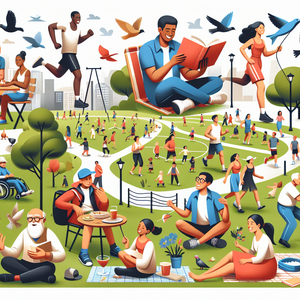The Intersection of Art and Therapy: Creative Solutions for Mental Health

Art therapy offers a wealth of benefits for clients struggling with mental health issues. At its core, art therapy provides individuals with a non-verbal outlet for expression, which can be particularly valuable for those who find it difficult to articulate their feelings. As clients engage in creative activities, they may discover new insights about themselves and their emotions, enabling deeper self-understanding and healing. Research supports the efficacy of art therapy in various contexts. A study published in the journal Art Therapy found that individuals who participated in art therapy reported reduced anxiety and depression levels, improved self-esteem, and enhanced emotional regulation. These findings suggest that creative expression can facilitate emotional processing and contribute to overall mental well-being. Moreover, art therapy can serve as a bridge for clients who may feel disconnected from traditional talk therapy, allowing them to engage in therapy in a manner that feels more natural and less intimidating.
Forms of Art Therapy
Art therapy is not limited to one specific medium; it encompasses a diverse range of creative practices. Some common forms include: 1. Visual Arts: Drawing, painting, and sculpture are traditional methods that encourage clients to explore their emotions through visual representation. For instance, a client might draw a chaotic scene to symbolize their feelings of overwhelm, providing a starting point for discussion in therapy. 2. Music Therapy: Music can be a powerful tool for emotional expression. Clients may engage in songwriting, improvisation, or simply listening to music that resonates with their feelings, facilitating deeper emotional exploration. 3. Dance and Movement Therapy: Movement can serve as a profound means of expression. Through dance, clients can release pent-up emotions and connect with their bodies, promoting a sense of empowerment and agency. 4. Drama Therapy: Role-playing and storytelling can help clients process their experiences from a distance, allowing them to explore different perspectives and develop coping strategies. Each of these forms of art therapy can be tailored to meet the unique needs of clients, ensuring that the therapeutic process is both personalized and effective.
Practical Applications in Counseling
Mental health counselors can effectively integrate art therapy into their practice by employing some of the following techniques: - Creating a Safe Space: Counselors should establish a comfortable and non-judgmental environment where clients feel free to express themselves creatively. This may involve providing art supplies, music, or even a space for movement. - Using Art as a Conversation Starter: Counselors can encourage clients to create art that reflects their current emotional state. The resulting artwork can serve as a focal point for conversation, enabling clients to articulate their feelings and thoughts more freely. - Setting Goals through Creativity: Counselors can guide clients to set specific therapeutic goals through creative projects. For example, a client might create a vision board that represents their aspirations, providing a tangible reminder of their objectives. - Incorporating Art into Homework Assignments: Encouraging clients to engage in creative activities outside of therapy sessions can reinforce the therapeutic process. Counselors can assign art-related tasks that align with the client’s treatment goals, such as journaling through drawing or creating a collage that represents their journey.
Opportunities for All in Art Therapy
The integration of art therapy into mental health practices opens a range of opportunities for individuals from all walks of life. As a career consideration, mental health counselors can benefit from: - Developing Emotional Intelligence: Working in art therapy requires counselors to enhance their emotional intelligence, allowing them to connect deeply with their clients. - Fostering Creativity in Therapeutic Settings: Counselors can explore innovative approaches to therapy that engage clients and make the therapeutic process more dynamic. - Expanding Their Skill Set: By incorporating art therapy techniques, counselors can broaden their professional abilities, making them more versatile in addressing diverse client needs. - Promoting Multidisciplinary Collaboration: Art therapists can collaborate with other healthcare professionals, enriching the overall treatment landscape for clients with mental health issues. - Increasing Accessibility to Therapy: Art therapy can reach individuals who may be resistant to traditional forms of therapy, promoting inclusivity and access to mental health support.
The intersection of art and therapy offers a rich and engaging avenue for mental health counselors to foster emotional expression and healing. By incorporating creative methods into their practice, counselors can enhance their clients' therapeutic experiences, leading to deeper self-exploration and more effective problem-solving. As the mental health landscape continues to evolve, embracing innovative approaches like art therapy can empower both counselors and clients to navigate the complexities of emotional well-being with creativity, compassion, and resilience. Ultimately, the integration of art into therapy not only enriches the therapeutic process but also highlights the profound connection between creativity and mental health, opening new pathways for healing and personal growth. The potential for transformative change is immense, making art therapy a vital component of contemporary mental health care.
Art Therapist
Core Responsibilities
Develop and implement individualized art therapy plans tailored to clients’ emotional and psychological needs.
Facilitate art-making sessions, guiding clients in various artistic mediums to explore their feelings and experiences.
Assess client progress and adapt therapeutic goals based on ongoing evaluations.
Required Skills
Master's degree in art therapy or a related field, and state licensure as a professional art therapist.
Strong understanding of psychological principles and therapeutic techniques.
Proficiency in various art mediums and the ability to foster a safe space for creative exploration.
Common Employers
Hospitals
Community mental health centers
Rehabilitation facilities
Private practices
Music Therapist
Core Responsibilities
Design and conduct music therapy sessions to address individual client goals, such as improving emotional well-being and social skills.
Utilize songwriting, improvisation, and listening activities to facilitate emotional expression and communication.
Monitor and document client progress, adjusting therapeutic strategies as needed.
Required Skills
Master’s degree in music therapy and board certification (MT-BC).
Knowledge of music theory and various musical instruments.
Excellent interpersonal skills to build rapport with clients and engage them in the therapeutic process.
Common Employers
Schools
Mental health facilities
Nursing homes
Private practices
Dance Movement Therapist
Core Responsibilities
Create movement-based therapeutic interventions designed to support emotional, cognitive, and physical well-being.
Facilitate group and individual sessions that encourage self-expression through body movement.
Collaborate with other healthcare professionals to integrate movement therapy into holistic treatment plans.
Required Skills
Master's degree in dance/movement therapy and certification from a recognized body (e.g., ADTA).
Strong background in dance, body awareness, and non-verbal communication techniques.
Empathy and the ability to create a safe environment for exploration and expression.
Common Employers
Rehabilitation centers
Mental health clinics
Wellness programs
Educational institutions
Drama Therapist
Core Responsibilities
Use role-play, storytelling, and improvisation to help clients articulate feelings and explore personal narratives.
Facilitate therapeutic drama sessions that encourage clients to express themselves in a creative and supportive environment.
Evaluate clients’ emotional and psychological needs to tailor interventions effectively.
Required Skills
Master’s degree in drama therapy or a related field and certification from a recognized organization.
Strong understanding of theatrical techniques and their therapeutic applications.
Ability to foster creativity and openness in clients, creating a safe environment for exploration.
Common Employers
Mental health agencies
Schools
Community centers
Private practices
Expressive Arts Therapist
Core Responsibilities
Integrate multiple art forms (visual arts, music, dance, and drama) to create a holistic therapeutic experience for clients.
Assess client needs and design integrated art therapy programs that facilitate self-exploration and healing.
Facilitate group sessions that promote collaboration and community building through creative expression.
Required Skills
Master’s degree in expressive arts therapy or a related field, with training in various art modalities.
Strong facilitation skills and the ability to create a welcoming and inclusive environment.
Knowledge of developmental and psychological theories related to art and creativity.
Common Employers
Mental health clinics
Educational institutions
Nonprofit organizations
Hospitals


